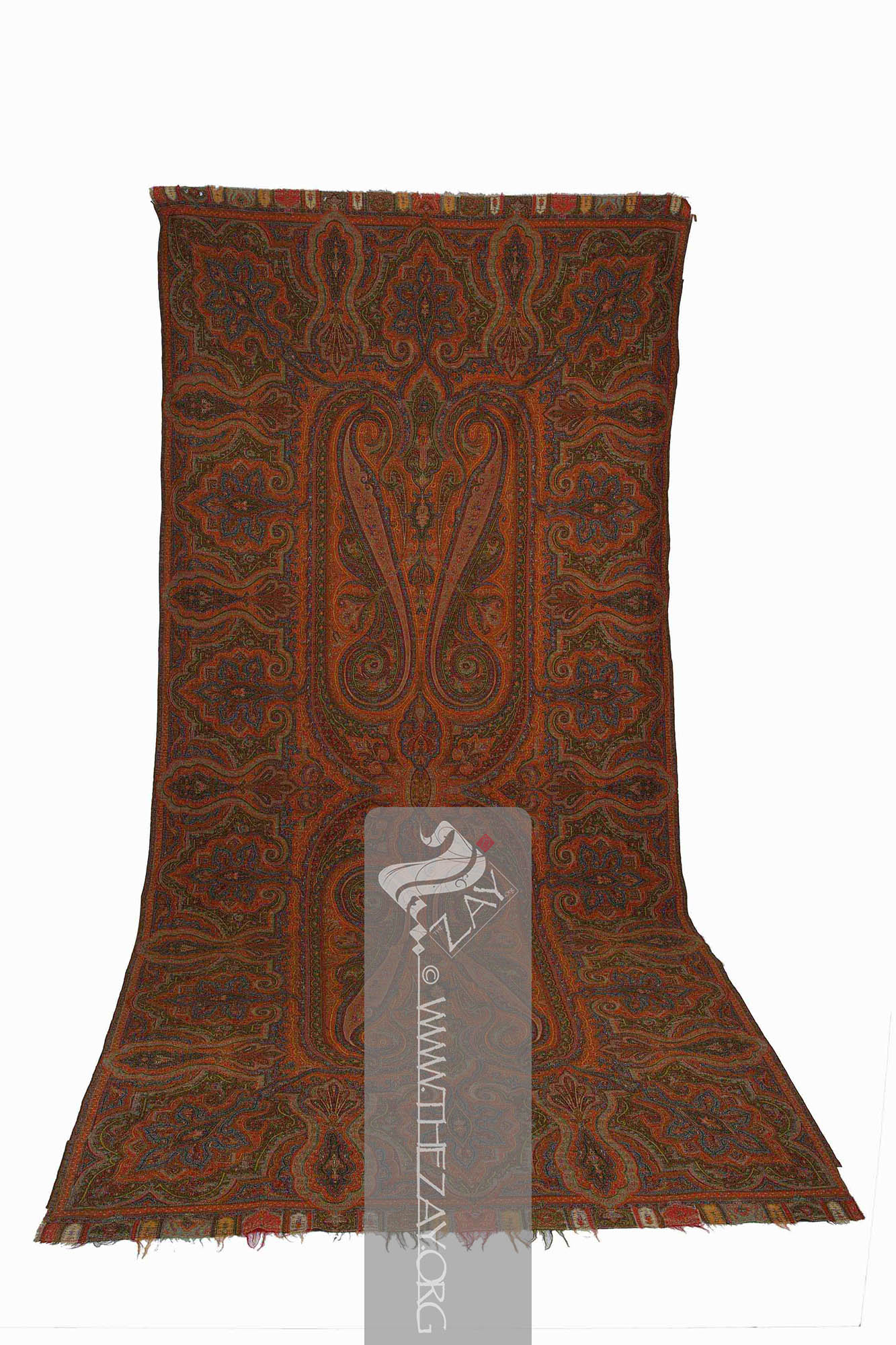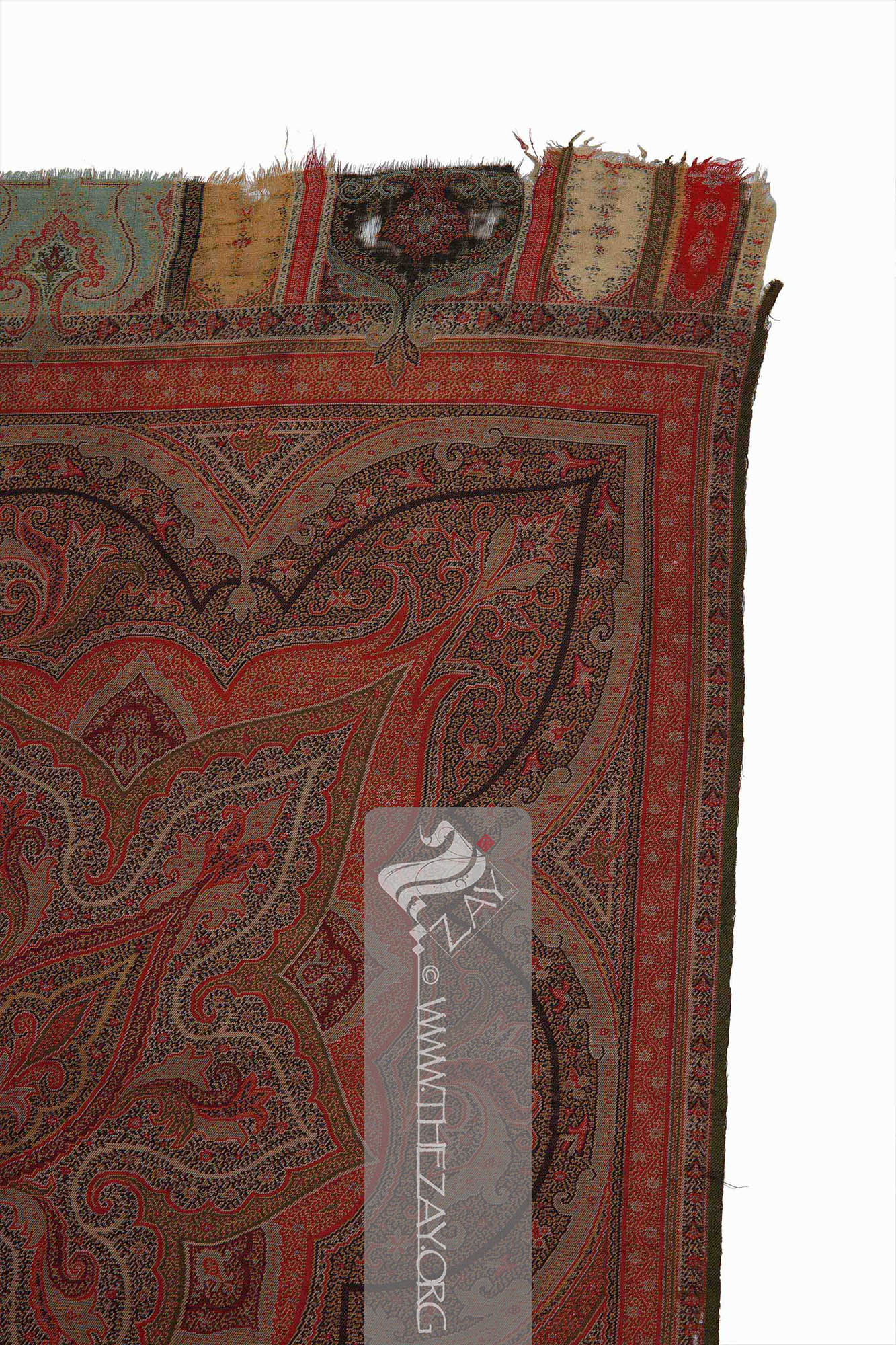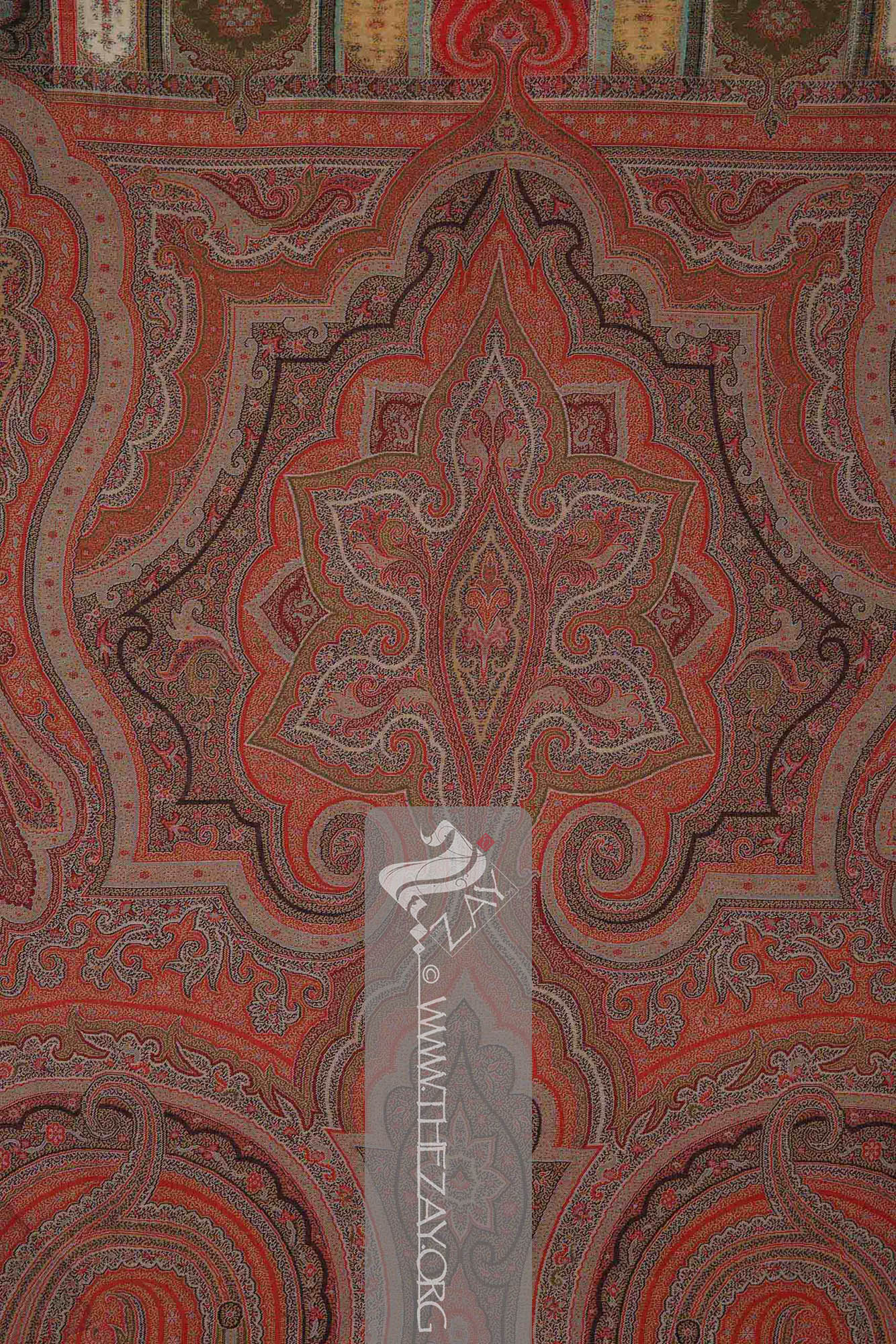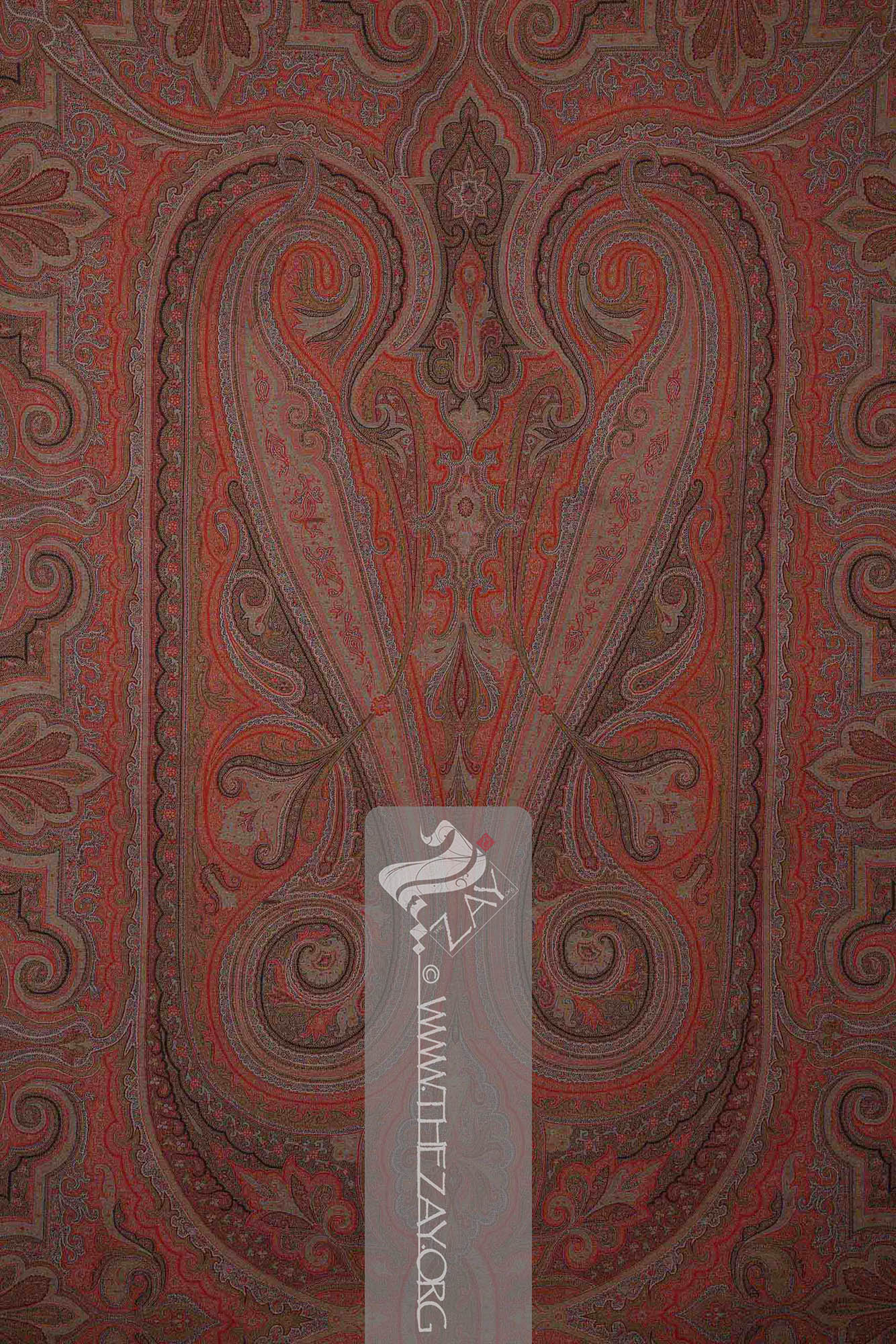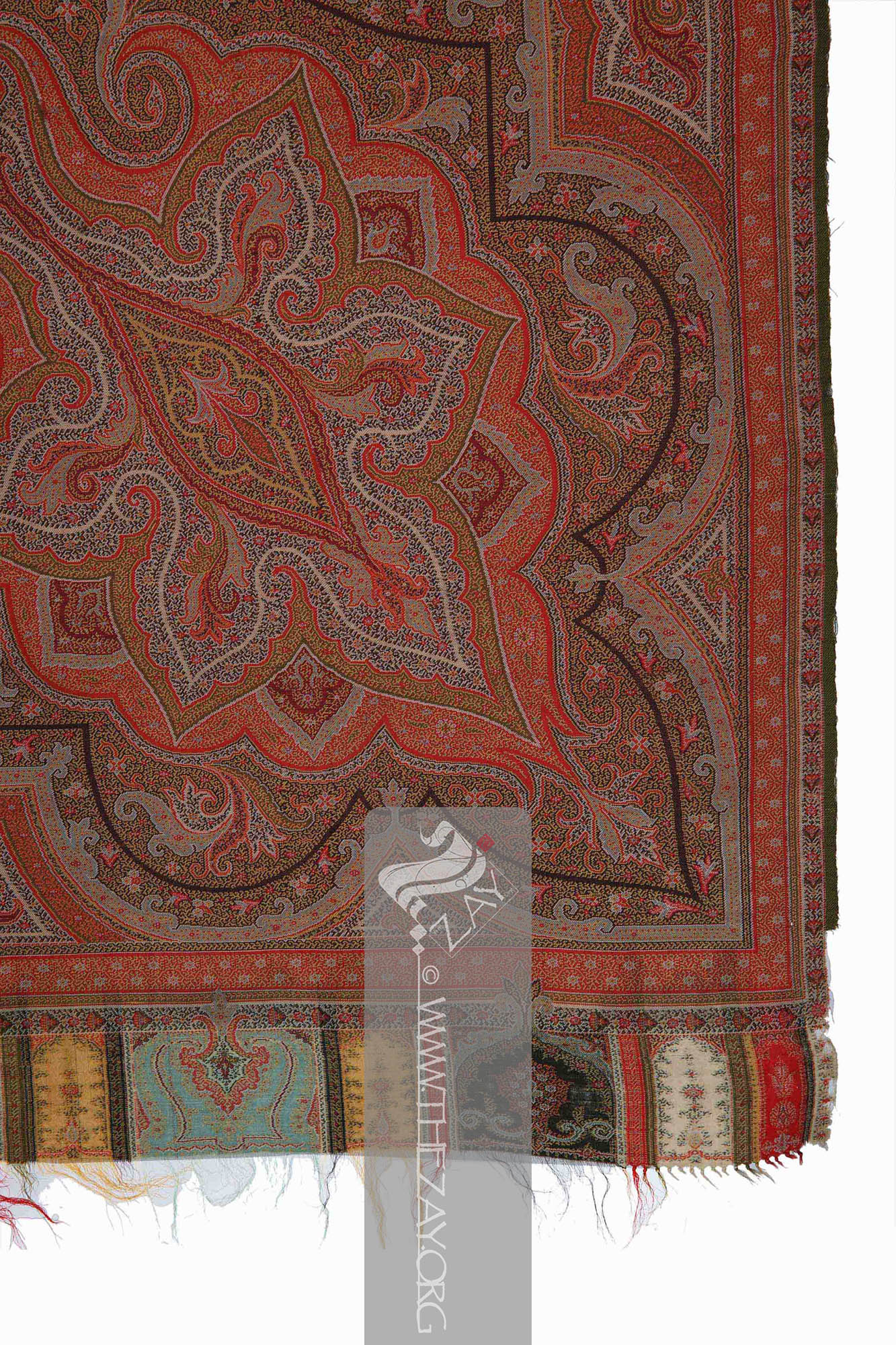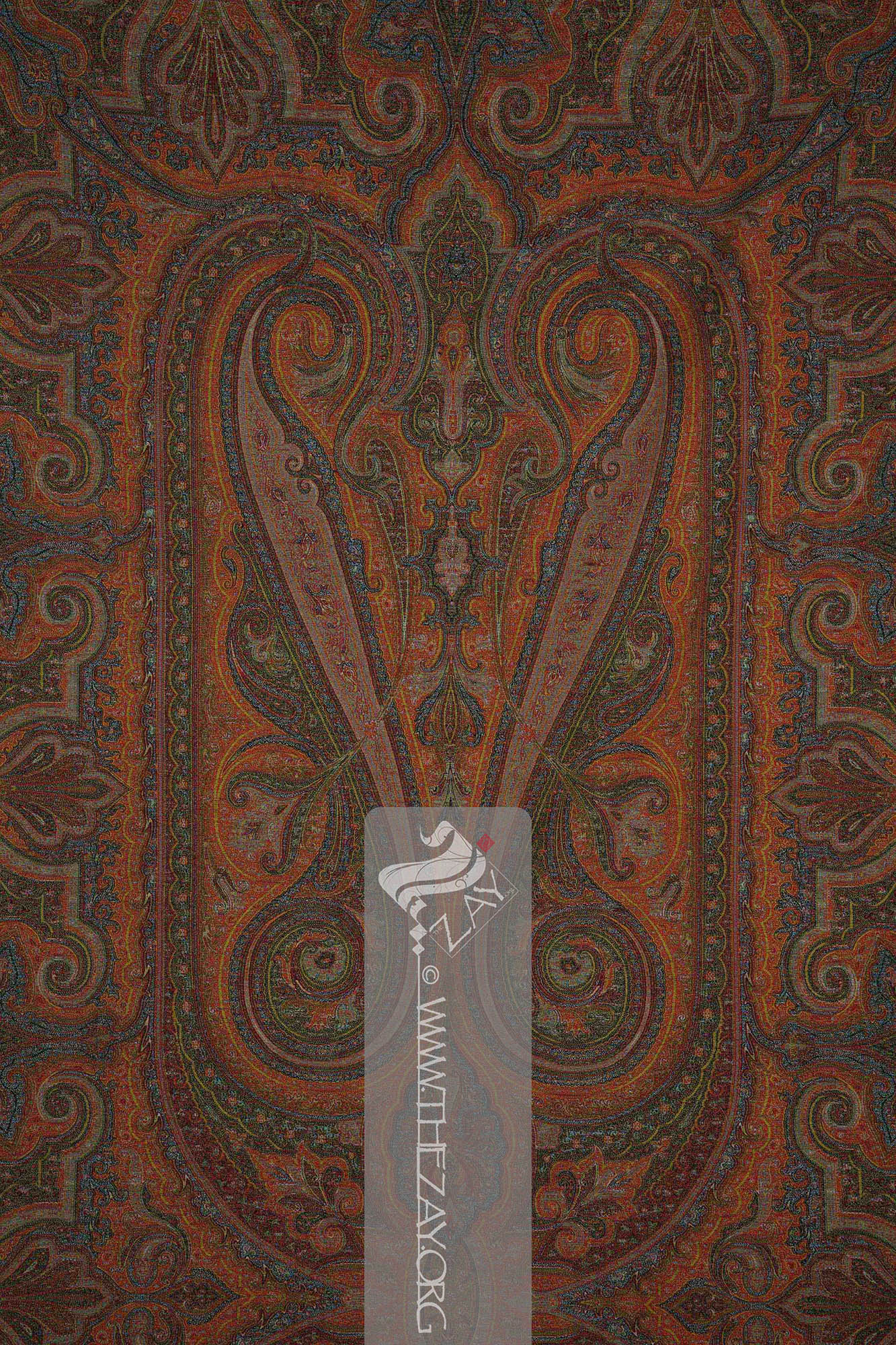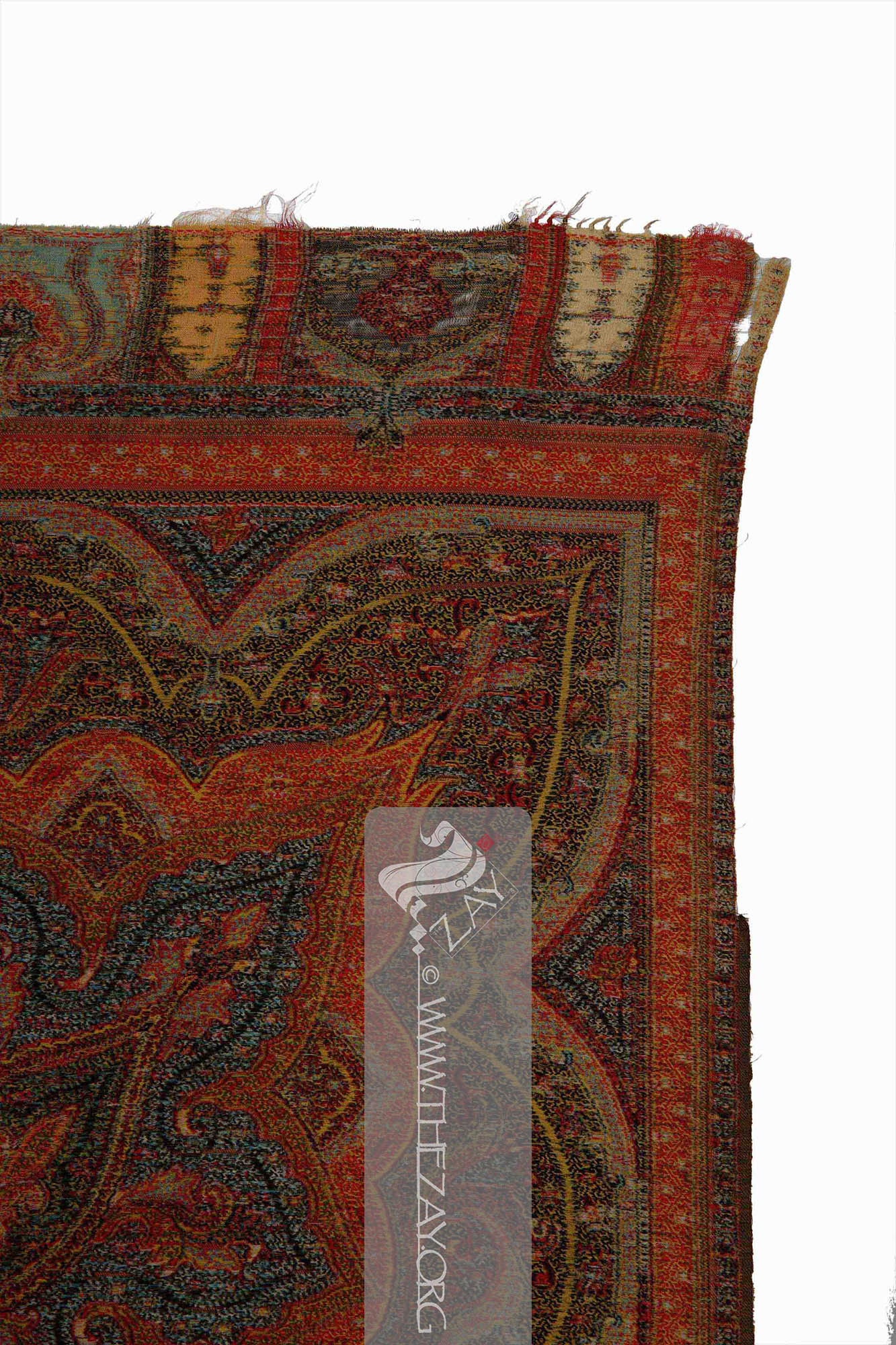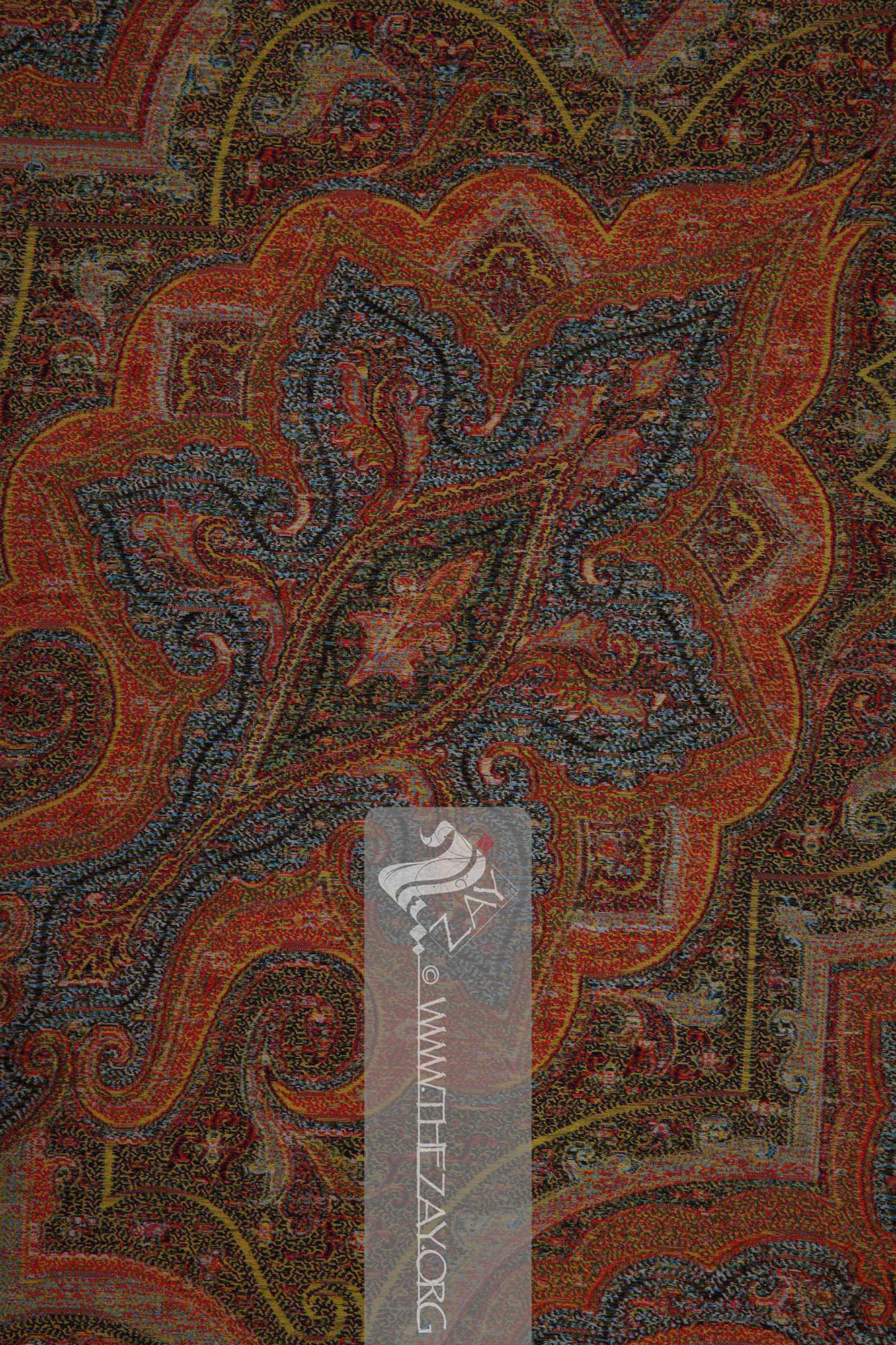Object HistoryIn the summer of 2021, Dr. Reem El Mutwalli came across this
shawl
Shawl: (Persian: shāl from Hindi: duśālā – Shoulder Mantle), a shawl is a South Asian version of a scarf worn or wrapped loosely over the shoulders and is usually made of wool. through a textile dealer based in New York and purchased it to add to the
Zay
Zay: (Arabic: costume, Pl. azyaā’), a set of clothes in a style typical of a particular country or historical period. Collection.
Object Features This (
jamawar
Jamawar: (Hindi, Jama: robe and war/var: chest or body), a portmanteau word meaning anything that covers the body. Originally brocade silk of intricate and overlapping patterns first introduced by the traders from Samarkand and Bukhara to the subcontinent and was adopted in wool specifically in pashmina
Pāshmīna: (Persian: pašm or pashm – wool), pashmina scarves are eponymous woolen shawls from the Kashmir region with a history dating back to more than 500 years. It is the finest variant of spun cashmere wool extracted from the downy undercoat of the Changthangi goats found in the Ladakh province. .
) style (
long_shawl
Long_Shawl
Shawl: (Persian: shāl from Hindi: duśālā – Shoulder Mantle), a shawl is a South Asian version of a scarf worn or wrapped loosely over the shoulders and is usually made of wool. : (Synonym: Kirking Shawl
Shawl: (Persian: shāl from Hindi: duśālā – Shoulder Mantle), a shawl is a South Asian version of a scarf worn or wrapped loosely over the shoulders and is usually made of wool. ), European versions of and inspired by Kashmiri double shawl
Shawl: (Persian: shāl from Hindi: duśālā – Shoulder Mantle), a shawl is a South Asian version of a scarf worn or wrapped loosely over the shoulders and is usually made of wool. s in wool or silk manufactured locally in Europe. As a part of the trousseau for aristocratic women, it was often used at their first post-wedding church services and christenings. ) is woven in colourful wool in a
Kashmiri
Kashmiri: (Hindustani: Kashmir – a region in South Asia), a term used to denote or identify anything related to the region – its people, their language, culture, art and craft, society etc. flavour and (
kani
Kani: (Kashmiri
Kashmiri: (Hindustani: Kashmir – a region in South Asia), a term used to denote or identify anything related to the region – its people, their language, culture, art and craft, society etc. : Small sticks, also a name of a village in Kashmir), a type of weave that originated in this village where wooden bobbins or sticks are used as spools on the loom to create intricate patterns instead of a shuttle.
) weave. Although nothing is known about its origin and provenance from its wool quality, dimensions, and weaving techniques, it could be estimated that perhaps it is of European origin – France, Scotland – c. 19th century – possibly between c. 1830-1850.
Assuming its European origin, however, it is void of any typical characteristics in design and design distribution from its contemporaries. Instead of having a plain rectangular ground – a very common design for long shawls of European origin – this (
shawl
Shawl: (Persian: shāl from Hindi: duśālā – Shoulder Mantle), a shawl is a South Asian version of a scarf worn or wrapped loosely over the shoulders and is usually made of wool. ) has a myriad of complex and dense design distribution that has been intricately and skilfully executed resembling a
Kashmiri
Kashmiri: (Hindustani: Kashmir – a region in South Asia), a term used to denote or identify anything related to the region – its people, their language, culture, art and craft, society etc. jamawar
Jamawar: (Hindi, Jama: robe and war/var: chest or body), a portmanteau word meaning anything that covers the body. Originally brocade silk of intricate and overlapping patterns first introduced by the traders from Samarkand and Bukhara to the subcontinent and was adopted in wool specifically in pashmina
Pāshmīna: (Persian: pašm or pashm – wool), pashmina scarves are eponymous woolen shawls from the Kashmir region with a history dating back to more than 500 years. It is the finest variant of spun cashmere wool extracted from the downy undercoat of the Changthangi goats found in the Ladakh province. .
shawl
Shawl: (Persian: shāl from Hindi: duśālā – Shoulder Mantle), a shawl is a South Asian version of a scarf worn or wrapped loosely over the shoulders and is usually made of wool. .
It has a thin border running along its edge on all four sides framing the large central panel. The border is composed of floral patterns and arrangements primarily in (
madder
Madder: (Latin: Rubia tinctorum – Eurasian herb), rose madder, common madder or dyer's madder is a vegetable dye made from the roots of a perennial plant belonging to the bedstraw and coffee family. It has been used extensively as a vegetable red dye across the globe from India to England.
) red, with highlights of beige.
The (
warp
Warp: One of the two basic components used in weaving which transforms thread or yarns to a piece of fabric. The warp is the set of yarns stretched longitudinally in place on a loom before the weft
Weft: one of the two basic components used in weaving that transforms thread or yarns into a piece of fabric. It is the crosswise thread on a loom that is passed over and under the warp threads. is introduced during the weaving process. ) ends have an extra layer of the border that is composed of colourful rectangular patches with stylized arches that encase several floral motifs or bouquets. These patches are made of black, (
turquoise
Turquoise: (French: turquois – present day Türkiye; Synonyms: firuze, pheroza), is a naturally occurring opaque mineral mined in abundance in Khorasan province of Iran and has been used for making dye for centuries. The term is a derivative of the French word for the country Türkiye once called Turkey. )/(
pheroza
: (Persian: pērōzah – "victory", later Arabic: fayrūz; Synonyms: firuze, turquoise
Turquoise: (French: turquois – present day Türkiye; Synonyms: firuze, pheroza), is a naturally occurring opaque mineral mined in abundance in Khorasan province of Iran and has been used for making dye for centuries. The term is a derivative of the French word for the country Türkiye once called Turkey. ), is a naturally occurring opaque mineral mined in abundance in Khorasan province of Iran and has been used for making dye for centuries. ), scarlet red, ivory and olive green with a beige patch interjecting two colours.
The body of the
shawl
Shawl: (Persian: shāl from Hindi: duśālā – Shoulder Mantle), a shawl is a South Asian version of a scarf worn or wrapped loosely over the shoulders and is usually made of wool. or the (
matan
Matan: (Arabic, middle of the thing), the main field of a shawl
Shawl: (Persian: shāl from Hindi: duśālā – Shoulder Mantle), a shawl is a South Asian version of a scarf worn or wrapped loosely over the shoulders and is usually made of wool. . ) can be roughly divided into two parts. The central part is composed of four large stylised (
paisley
Paisley: (Scottish Gaelic, Pàislig: a town in Scotland), often called buta, boteh, amli, or kalgi in the subcontinent and kazuwah in Arabic, is a Persian tear drop motif with a curved end specially in textiles. Its popularity and subsequent local production in 18th century at Paisley are responsible for its nomenclature.)/(
buta
Būta: (Anglicized Persian: boteh – Pinecone shaped motif), known as paisley
Paisley: (Scottish Gaelic, Pàislig: a town in Scotland), often called buta, boteh, amli, or kalgi in the subcontinent and kazuwah in Arabic, is a Persian tear drop motif with a curved end specially in textiles. Its popularity and subsequent local production in 18th century at Paisley are responsible for its nomenclature. in English it is the almond or pinecone-shaped motif, especially in textiles. It is believed to have originated from the Cyprus tree a Zoroastrian symbol for life and eternity. In the current Indian context, however, it simply means motif.) set in pairs. In each pair, the paisleys elegantly curl around each other. The arrangement of each pair is a mirrored reflection of the other thus creating an illusion of a butterfly. The other part is composed of two motifs placed side by side – a bouquet and a stylised (
palmette
Palmette: (French: Palmette – Small palm, synonym Greco-Roman: Anthemion), a decorative element, motif, or ornament particularly pertaining to designs of architecture and decorative arts that has radiating petals resembling a palm leaf. It is believed to have originated in ancient Egypt and had subsequently reached far and wide. ) – repeated several times along the sides framing the central part. The entire body is composed of (
coral
Coral: (Greek: korallion, probably from Hebrew: goral – small pebbles), is a pale to medium shade of pink with orange or peach undertones, resembling the colour of certain species of coral.) pink,
madder
Madder: (Latin: Rubia tinctorum – Eurasian herb), rose madder, common madder or dyer's madder is a vegetable dye made from the roots of a perennial plant belonging to the bedstraw and coffee family. It has been used extensively as a vegetable red dye across the globe from India to England.
, (
crimson
Crimson: (Persian/Arabic and Turkish: qirmiz or kirmiz – red), is a vivid red color originally made from the dried bodies of a scale insect of the Kermes genus native to the Mediterranean region and was used as a dye for clothing and textiles.) red,
turquoise
Turquoise: (French: turquois – present day Türkiye; Synonyms: firuze, pheroza), is a naturally occurring opaque mineral mined in abundance in Khorasan province of Iran and has been used for making dye for centuries. The term is a derivative of the French word for the country Türkiye once called Turkey. , black and beige. A series of threads in the corresponding colour of the patches hang loose forming a fringe enhancing the
shawl
Shawl: (Persian: shāl from Hindi: duśālā – Shoulder Mantle), a shawl is a South Asian version of a scarf worn or wrapped loosely over the shoulders and is usually made of wool. ’s elegance.
While typical
Kashmiri
Kashmiri: (Hindustani: Kashmir – a region in South Asia), a term used to denote or identify anything related to the region – its people, their language, culture, art and craft, society etc. jamawar
Jamawar: (Hindi, Jama: robe and war/var: chest or body), a portmanteau word meaning anything that covers the body. Originally brocade silk of intricate and overlapping patterns first introduced by the traders from Samarkand and Bukhara to the subcontinent and was adopted in wool specifically in pashmina
Pāshmīna: (Persian: pašm or pashm – wool), pashmina scarves are eponymous woolen shawls from the Kashmir region with a history dating back to more than 500 years. It is the finest variant of spun cashmere wool extracted from the downy undercoat of the Changthangi goats found in the Ladakh province. .
shawls were larger and composed of separately woven patches skilfully attached to one another by means of hand stitches to create a single
shawl
Shawl: (Persian: shāl from Hindi: duśālā – Shoulder Mantle), a shawl is a South Asian version of a scarf worn or wrapped loosely over the shoulders and is usually made of wool. , this is a (
selvedge
Selvedge: (English: Self-finished edge or self-edge: a dialect forming transition), an edge produced on woven fabric during manufacture that prevents it from unravelling. Traditionally the term selvage applied to only loom woven fabric, presently it could be applied to flat knitted fabric too. ) to
selvedge
Selvedge: (English: Self-finished edge or self-edge: a dialect forming transition), an edge produced on woven fabric during manufacture that prevents it from unravelling. Traditionally the term selvage applied to only loom woven fabric, presently it could be applied to flat knitted fabric too. woven piece. This piece is quite similar in its style of execution to another piece in the collection of the
Zay
Zay: (Arabic: costume, Pl. azyaā’), a set of clothes in a style typical of a particular country or historical period. Initiative – (
ZI2020.500774 EUROPE).
Links
- Irwin, John. The Kashmir Shawls. Her Majesty's Stationary Office, 1981.
- Thornton, Zita. "The Norwich Shawl
Shawl: (Persian: shāl from Hindi: duśālā – Shoulder Mantle), a shawl is a South Asian version of a scarf worn or wrapped loosely over the shoulders and is usually made of wool. ." Antiques Info, vol. 4, 2001, http://www.antiques-info.co.uk/new/pdf/Mar01/4.pdf
- Skarratt, Ben. "From India to Europe: The Production of the Kashmir Shawl
Shawl: (Persian: shāl from Hindi: duśālā – Shoulder Mantle), a shawl is a South Asian version of a scarf worn or wrapped loosely over the shoulders and is usually made of wool. and the Spread of the Paisley
Paisley: (Scottish Gaelic, Pàislig: a town in Scotland), often called buta, boteh, amli, or kalgi in the subcontinent and kazuwah in Arabic, is a Persian tear drop motif with a curved end specially in textiles. Its popularity and subsequent local production in 18th century at Paisley are responsible for its nomenclature. Motif." Global History of Capitalism, University of Oxford, 2018, https://globalcapitalism.history.ox.ac.uk/sites/default/files/globalcapitalism/documents/media/case_04_-_the_paisley_0.pdf
- Sethi, Ritu. Handmade for the 21st Century: Safeguarding Traditional Indian Textiles. UNESCO, 2022.
- Quaile, Sheilagh Dr. "Cashmere
Cashmere: (Anglisized from Hindustani: Kashmir – A region or province in the Indian subcontinent), a fine soft natural wool, from the hair of goats native to the Kashmir, Ladakh and neighbouring regions of the Indian subcontinent. Often confused with Pashmina
Pāshmīna: (Persian: pašm or pashm – wool), pashmina scarves are eponymous woolen shawls from the Kashmir region with a history dating back to more than 500 years. It is the finest variant of spun cashmere wool extracted from the downy undercoat of the Changthangi goats found in the Ladakh province. , it should be noted that all cashmeres are not pashmina
Pāshmīna: (Persian: pašm or pashm – wool), pashmina scarves are eponymous woolen shawls from the Kashmir region with a history dating back to more than 500 years. It is the finest variant of spun cashmere wool extracted from the downy undercoat of the Changthangi goats found in the Ladakh province. . Shawls." Khan Academy, www.khanacademy.org/humanities/art-asia/south-asia/x97ec695a:1500-1850-deccan-south/a/cashmere
Cashmere: (Anglisized from Hindustani: Kashmir – A region or province in the Indian subcontinent), a fine soft natural wool, from the hair of goats native to the Kashmir, Ladakh and neighbouring regions of the Indian subcontinent. Often confused with Pashmina
Pāshmīna: (Persian: pašm or pashm – wool), pashmina scarves are eponymous woolen shawls from the Kashmir region with a history dating back to more than 500 years. It is the finest variant of spun cashmere wool extracted from the downy undercoat of the Changthangi goats found in the Ladakh province. , it should be noted that all cashmeres are not pashmina
Pāshmīna: (Persian: pašm or pashm – wool), pashmina scarves are eponymous woolen shawls from the Kashmir region with a history dating back to more than 500 years. It is the finest variant of spun cashmere wool extracted from the downy undercoat of the Changthangi goats found in the Ladakh province. . -shawls
- Van Schoor, Jennifer Ann (2019) The Indian cashmere
Cashmere: (Anglisized from Hindustani: Kashmir – A region or province in the Indian subcontinent), a fine soft natural wool, from the hair of goats native to the Kashmir, Ladakh and neighbouring regions of the Indian subcontinent. Often confused with Pashmina
Pāshmīna: (Persian: pašm or pashm – wool), pashmina scarves are eponymous woolen shawls from the Kashmir region with a history dating back to more than 500 years. It is the finest variant of spun cashmere wool extracted from the downy undercoat of the Changthangi goats found in the Ladakh province. , it should be noted that all cashmeres are not pashmina
Pāshmīna: (Persian: pašm or pashm – wool), pashmina scarves are eponymous woolen shawls from the Kashmir region with a history dating back to more than 500 years. It is the finest variant of spun cashmere wool extracted from the downy undercoat of the Changthangi goats found in the Ladakh province. . shawl
Shawl: (Persian: shāl from Hindi: duśālā – Shoulder Mantle), a shawl is a South Asian version of a scarf worn or wrapped loosely over the shoulders and is usually made of wool. and social status in British art, 1760-1870. [Thesis] (Unpublished) https://eprints.bbk.ac.uk/id/eprint/40406/1/VAN%20SCHOOR%20J.A.%20–%20PHD%202019-vol%201.pdf
- Andrew Newey, “Cashmere
Cashmere: (Anglisized from Hindustani: Kashmir – A region or province in the Indian subcontinent), a fine soft natural wool, from the hair of goats native to the Kashmir, Ladakh and neighbouring regions of the Indian subcontinent. Often confused with Pashmina
Pāshmīna: (Persian: pašm or pashm – wool), pashmina scarves are eponymous woolen shawls from the Kashmir region with a history dating back to more than 500 years. It is the finest variant of spun cashmere wool extracted from the downy undercoat of the Changthangi goats found in the Ladakh province. , it should be noted that all cashmeres are not pashmina
Pāshmīna: (Persian: pašm or pashm – wool), pashmina scarves are eponymous woolen shawls from the Kashmir region with a history dating back to more than 500 years. It is the finest variant of spun cashmere wool extracted from the downy undercoat of the Changthangi goats found in the Ladakh province. . Country: The Perils of Making the World’s Finest Fabric,” The Guardian (10 January 2020), https://www.theguardian.com/environment/2020/jan/10/cashmere
Cashmere: (Anglisized from Hindustani: Kashmir – A region or province in the Indian subcontinent), a fine soft natural wool, from the hair of goats native to the Kashmir, Ladakh and neighbouring regions of the Indian subcontinent. Often confused with Pashmina
Pāshmīna: (Persian: pašm or pashm – wool), pashmina scarves are eponymous woolen shawls from the Kashmir region with a history dating back to more than 500 years. It is the finest variant of spun cashmere wool extracted from the downy undercoat of the Changthangi goats found in the Ladakh province. , it should be noted that all cashmeres are not pashmina
Pāshmīna: (Persian: pašm or pashm – wool), pashmina scarves are eponymous woolen shawls from the Kashmir region with a history dating back to more than 500 years. It is the finest variant of spun cashmere wool extracted from the downy undercoat of the Changthangi goats found in the Ladakh province. . -country-the-perils-of-making-the-worlds-finest-fabric
- Zutshi, Chitralekha. "Designed for Eternity: Kashmiri
Kashmiri: (Hindustani: Kashmir – a region in South Asia), a term used to denote or identify anything related to the region – its people, their language, culture, art and craft, society etc. Shawls, Empire, and Cultures of Production and Consumption in Mid-Victorian Britain." The Journal of British Studies, vol. 48, no. 2, 2009,https://www.cambridge.org/core/journals/journal-of-british-studies/article/abs/designed-for-eternity-kashmiri
Kashmiri: (Hindustani: Kashmir – a region in South Asia), a term used to denote or identify anything related to the region – its people, their language, culture, art and craft, society etc. -shawls-empire-and-cultures-of-production-and-consumption-in-midvictorian-britain/8BC637E16F9C0009A4A8097114FC630F
- A Kashmir Paisley
Paisley: (Scottish Gaelic, Pàislig: a town in Scotland), often called buta, boteh, amli, or kalgi in the subcontinent and kazuwah in Arabic, is a Persian tear drop motif with a curved end specially in textiles. Its popularity and subsequent local production in 18th century at Paisley are responsible for its nomenclature. Shawl
Shawl: (Persian: shāl from Hindi: duśālā – Shoulder Mantle), a shawl is a South Asian version of a scarf worn or wrapped loosely over the shoulders and is usually made of wool. , Christie’s, https://onlineonly.christies.com/s/collection-paul-f-walter/kashmir-paisley
Paisley: (Scottish Gaelic, Pàislig: a town in Scotland), often called buta, boteh, amli, or kalgi in the subcontinent and kazuwah in Arabic, is a Persian tear drop motif with a curved end specially in textiles. Its popularity and subsequent local production in 18th century at Paisley are responsible for its nomenclature.-shawl
Shawl: (Persian: shāl from Hindi: duśālā – Shoulder Mantle), a shawl is a South Asian version of a scarf worn or wrapped loosely over the shoulders and is usually made of wool. -616/46985
- Eastaugh, Nicky. "Norwich Shawls: Past Glory, Present Inspiration." Nicky Eastaugh's Learning Log for Textiles, 14 Oct. 2016, nickyeastaughmixedmediafortextiles.wordpress.com/2016/10/19/norwich-shawls-past-glory-present-inspiration-14-october-2016/.





